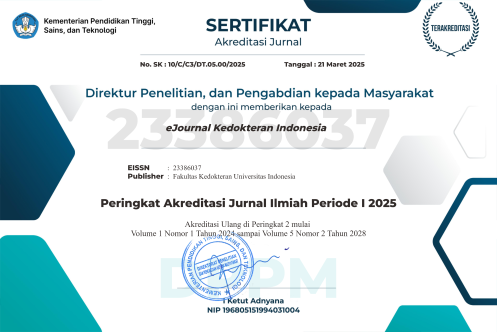Efek Stimulasi Titik Shenmen, Relaksasi, dan Zero Point terhadap Frekuensi Nadi dan Tekanan Darah Pasien Endoskopi Saluran Cerna Atas
DOI:
https://doi.org/10.23886/ejki.12.416.310Abstract
Endoskopi saluran cerna atas dapat memicu aktivasi saraf simpatis sehingga memengaruhi tanda vital yang diukur dari frekuensi nadi, pernapasan, dan tekanan darah. Penelitian ini bertujuan untuk mengevaluasi pengaruh stimulasi titik akupunktur telinga terhadap perubahan tanda vital selama prosedur endoskopi. Penelitian dilakukan dengan desain uji klinis acak tersamar tunggal dengan kelompok kontrol. Sebanyak 39 pasien yang menjalani endoskopi dibagi menjadi kelompok intervensi (20 pasien) dan kelompok kontrol (19 pasien). Pasien kelompok intervensi diberikan jarum Seirin Pyonex® press needles diameter 0,15 mm dan panjang 0,6 mm, yang diaplikasikan di tiga titik akupunktur telinga sebelum tindakan endoskopi saluran cerna atas dan tetap dipertahankan selama prosedur berlangsung. Pasien kelompok kontrol diberikan press needles sham di titik yang sama. Pengukuran tekanan darah dan frekuensi nadi dilakukan pada saat sebelum intervensi, selama prosedur endoskopi, dan 10 menit setelah endoskopi selesai. Hasil penelitian menunjukkan bahwa tidak terdapat perbedaan tekanan darah sistolik antara kedua kelompok pada setiap tahapan. Namun, saat pasien menelan endoskop, rerata tekanan darah diastolik pada kelompok sham lebih tinggi (86,4±20,49 mmHg) dibandingkan kelompok akupunktur (77,4±22,71 mmHg), meskipun perbedaan ini tidak signifikan secara statistik (p=0,12). Terdapat perbedaan signifikan (p=0,03) frekuensi nadi pada fase pemulihan kelompok akupunktur (77,3+12,17) dibandingkan dengan kelompok sham (86,2+13,20). Akupunktur telinga bisa dipertimbangkan sebagai intervensi tambahan untuk memberikan kenyamanan dan kestabilan tanda vital pasien saat menjalani endoskopi saluran cerna atas.
Kata kunci: endoskopi saluran cerna atas, akupunktur telinga, press needle, tanda vital.
Effects of Shenmen, Relaxation, and Zero Point Stimulation on Heart Rate and Blood Pressure in Patients Undergoing
Upper Gastrointestinal Endoscopy
Abstract
Upper gastrointestinal endoscopy can trigger sympathetic nerve activation, thereby affecting vital signs measured through pulse rate, respiration, and blood pressure. This study aims to evaluate the effect of auricular acupuncture point stimulation on changes in vital signs during the endoscopic procedure. A single-blind, randomized controlled clinical trial design was used. A total of 39 patients undergoing endoscopy were divided into two groups: the intervention group (20 patients) and the control group (19 patients). Patients in the intervention group received Seirin Pyonex® press needles with a diameter of 0.15 mm and a length of 0.6 mm, applied to three auricular acupuncture points prior to upper gastrointestinal endoscopy and maintained throughout the procedure. Control group patients received sham press needles at the same points. Blood pressure and pulse rate measurements were taken before the intervention, during the endoscopic procedure, and 10 minutes after completion. The results showed no difference in systolic blood pressure between the two groups at any stage. However, when patients swallowed the endoscope, the average diastolic blood pressure in the sham group was higher (86.4±20.49 mmHg) than in the acupuncture group (77.4±22.71 mmHg), although this difference was not statistically significant (p=0.12). A statistically significant difference (p=0.03) was found in the recovery phase for pulse rate, with the acupuncture group showing a lower average (77.3±12.17) compared to the sham group (86.2±13.20). Auricular acupuncture may be considered as an adjunctive intervention to support patient comfort and stabilize vital signs during upper gastrointestinal endoscopy.
Keywords: upper gastrointestinal endoscopy, auricular acupuncture, press needle, vital signs.
Downloads
Downloads
Published
How to Cite
Issue
Section
License
Copyright (c) 2025 Sri Wahdini, Adiningsih Srilestari, Hasan Mihardja, Murdani Abdullah

This work is licensed under a Creative Commons Attribution-NonCommercial 4.0 International License.
Accepted 2025-05-19
Published 2025-07-21



